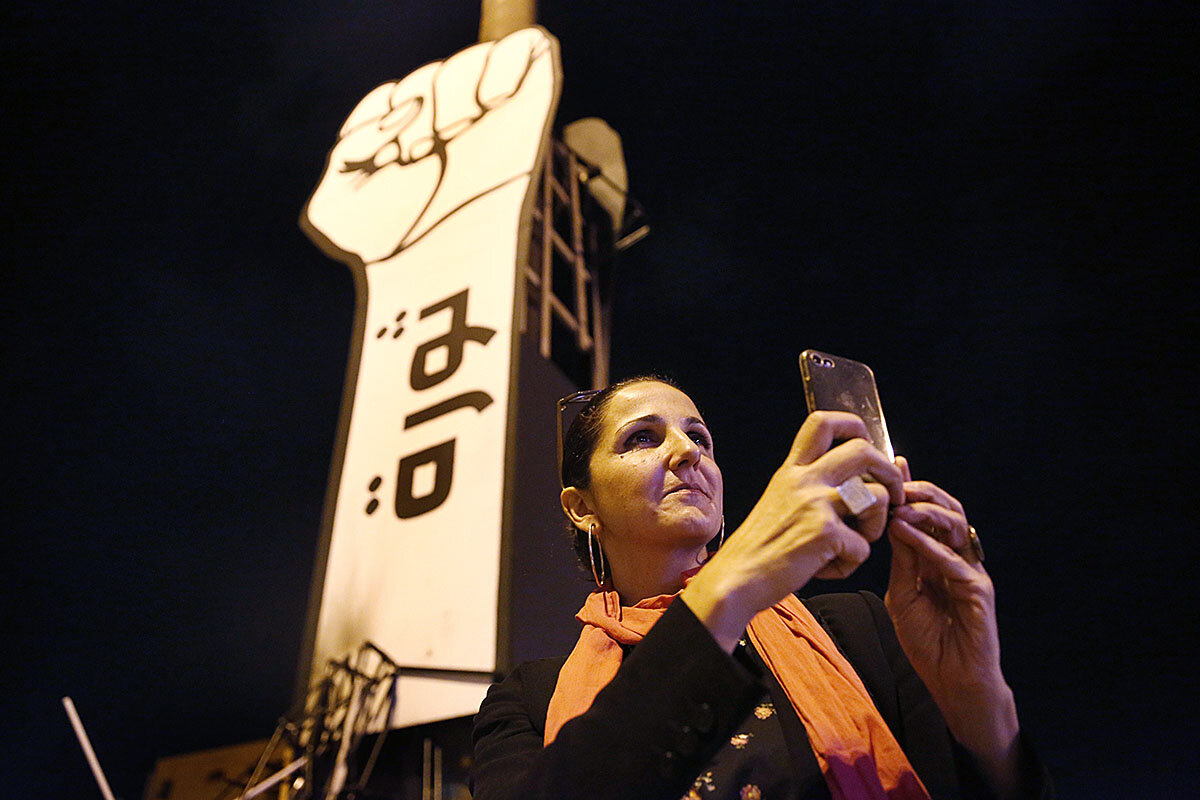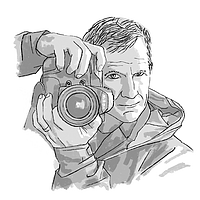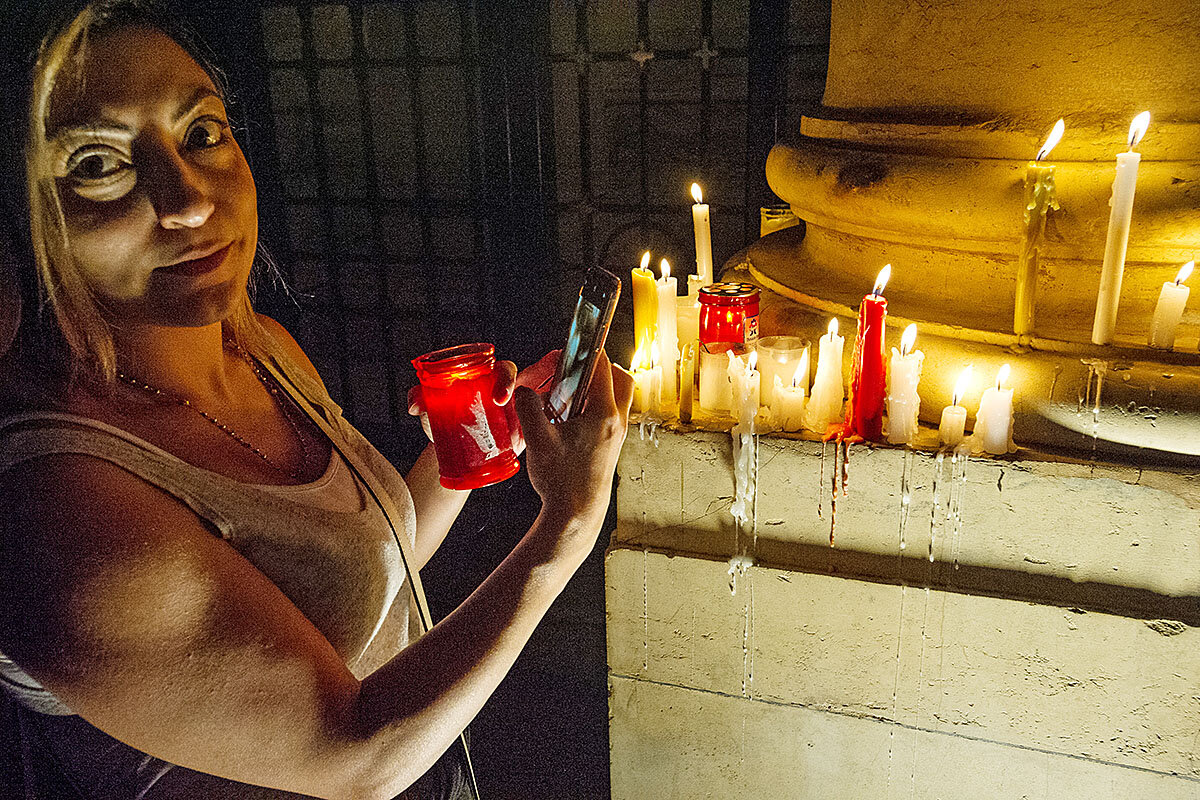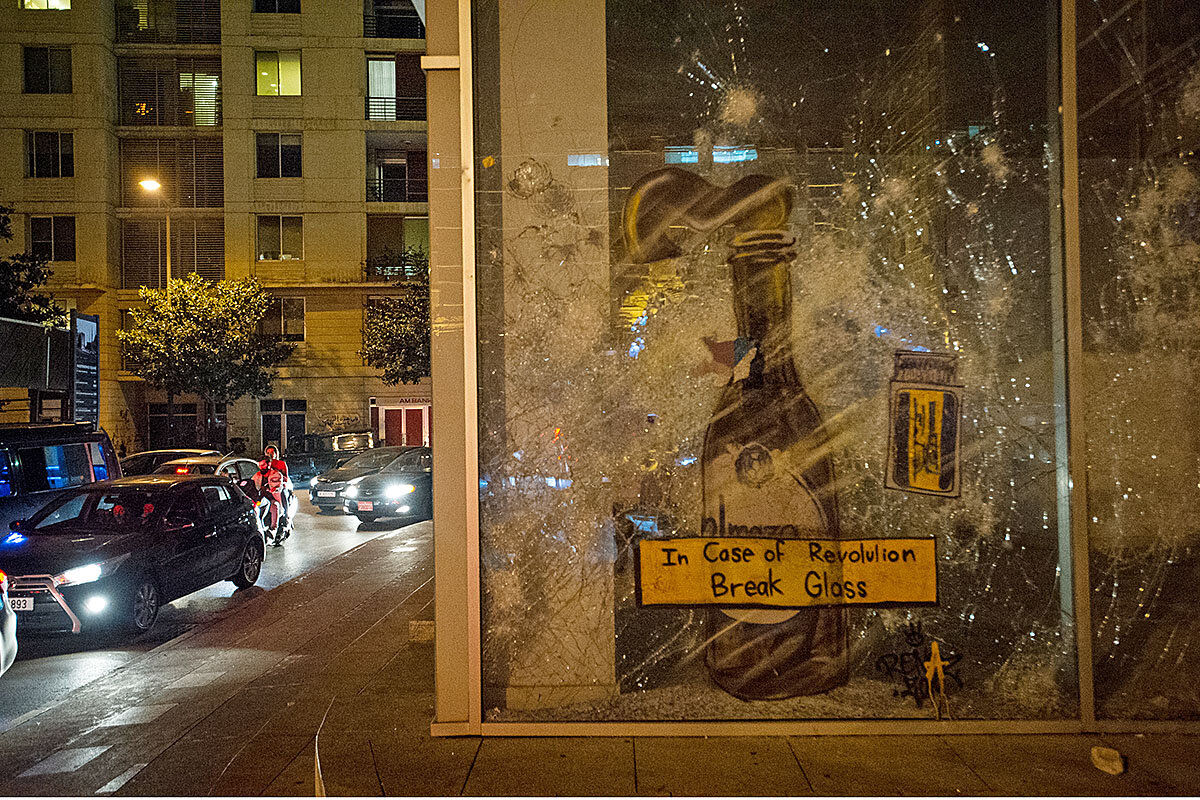From shattered glass and broken tents, Lebanese draw resolve
Loading...
| Beirut
Soaring high above Beirut’s central Martyrs’ Square, the focal point of a month of nationwide protests against decades of corrupt and sectarian rule in Lebanon, is a signboard of a clenched fist and the Arabic word for revolution.
But perhaps the most tangible symbol of defiance and resolve in this protest movement is found at the base of that clenched fist.
Here, like a shrine, protesters have collected the broken tent frames and smashed plastic chairs and tables left over after thugs armed with sticks and pipes – and chanting pro-Shiite slogans favoring the powerful Hezbollah and Amal parties – attacked the square in late October.
Why We Wrote This
Symbols inspire. In Lebanon’s protest movement, the national flag symbolizes unity above sectarianism. But in the smashed objects left behind after failed attempts to intimidate them, the protesters are finding resolve.
Within hours of the attack, the protest camp was erected anew. And those tens of thousands of Lebanese who continue to take to the streets every day, demanding change in cities and towns from north to south in a cross-sectarian campaign of sustained civil disobedience, count it as one more victory – and one more source of inspiration as they raise their voices.
“They attacked everyone; they were not behaving like Lebanese,” says Anita Mansour, a 30-something architect from Beirut, speaking beside the pile of revolutionary debris.
“They had been given orders, but it’s not going to work,” says Ms. Mansour, as she waits for an evening candlelight vigil and women’s march. “If they will come back, we will come back even stronger. It won’t stop until they stop. This is the first time I feel this unity – we are proud of this revolution.”
The attempt to intimidate the protesters by loyalists of Hezbollah and Amal – even though Shiite Lebanese, too, have taken to the streets in anger at the lack of services and rampant corruption in the strongholds of those powerful parties – only helped consolidate the uprising.
The symbols of resistance are resonant. Among the crowds are nationals from across the Arab world who see the Lebanese fight as universal, part of a renewed Arab Spring that has this year alone boiled angrily into the streets in Iraq, Algeria, Sudan, and Egypt.
“This was a shameful act, but it will give us more courage to stay,” says Nawras Abou Fakher, a bearded hipster and architect from Syria who has lived in Lebanon for five years, as he gazes at the pile of broken tents.
“We feel sorry for the people who did this, who can’t see [our] vision. This problem [of corruption] is coming to them, too,” he says. “This is a big monument for the revolution. We succeeded, as seen by this pile of stuff.
“This makes us feel we need to push for more,” adds Mr. Fakher. “This gives us more energy, because we are on the ground and peaceful, while they tried violence and it didn’t work.”
Lebanon’s uprising has been largely nonviolent, and its moments of violence have been turned into emblems of resistance. From protest stages, between DJs playing electronic dance music, speakers declare their defiance: “You beat us, we won’t move.”
And painted onto the smashed windows of one building on the square are the words: “In Case of Revolution, Break Glass.”
“We have gangsters”
But the violence has nevertheless been felt by – and has galvanized the anger of – people like Nabil Zeineddine, a Beirut taxi driver who shows his passengers pictures on his mobile phone of Lebanese security forces, in the first days of unrest, arresting and beating 57 protesters, including his son Hadi.
Mr. Zeineddine shows images of his 19-year-old son after a severe beating. His bare back and head are covered with welts and wounds, his forehead bleeding.
“Look what they did to him!” seethes Mr. Zeineddine, describing how his son’s head was kicked.
“We don’t have a government; we have gangsters,” he says. “We’re going to make sure, when this revolution is over, to try them in a court of law, those who beat these kids.”
Many Lebanese are still in awe of their own actions on the street, convinced they can remove a sectarian system entrenched for decades.
“Optimism is in the air, but there is still political pressure, so it is up and down,” says Rita, a protesting filmmaker who would only give her first name. “If people didn’t have hope, you wouldn’t see them in the streets.”
“For the first time there is a sense of solidarity among Lebanese people, regardless of religion and sect,” says Rita’s friend Nasrine, a primary school teacher. “For the first time our voice is heard.”
Need for accommodation
Protesters argue about the risk of renewed violence, with one man overheard stating about the ruling class: “These people will never stand down. They will burn Lebanon to ashes.”
But analysts say the case of Lebanon – which still bears the scars of a sectarian civil war fought here from 1975 to 1990 – is unlike many others in the Arab world.
“At some point, the old guard has to do a calculation of what, realistically, can they do?” says Rami Khouri, a professor at the American University of Beirut and fellow at Harvard’s Kennedy School.
“They can’t stay in power, just by using force,” says Professor Khouri. “The nature of the Lebanese system is not like Egypt or Syria, where the government can kill people, and beat them up, and arrest thousands, because the policemen you would send out on the streets to do this are being told to beat up their own brothers and neighbors and sisters.”
“So they can’t use force,” he says. “And political demonization doesn’t work; they tried it. So there needs to be some accommodation.”
But how will that play out in the future? All that Ms. Mansour knows is that Lebanon can’t go back to its old ways.
“We will be strong, we will not stop. We have changed our brains,” says the architect at the tent-rubble pile. “The most powerful force on earth is a soul on fire, and our souls are on fire.”







